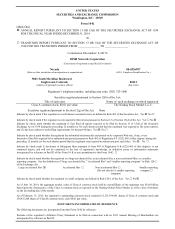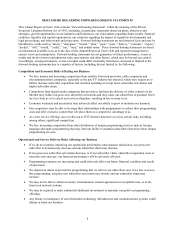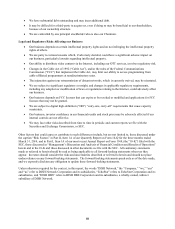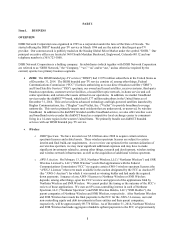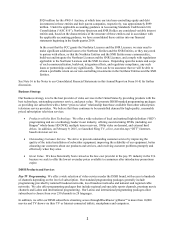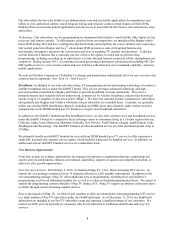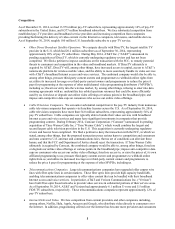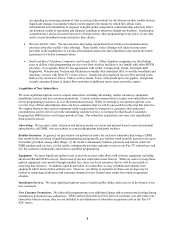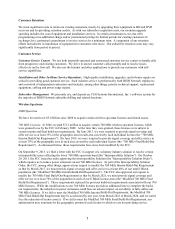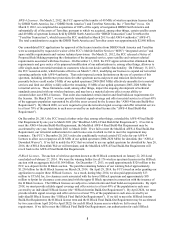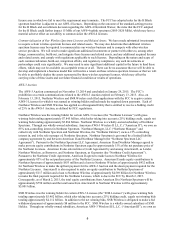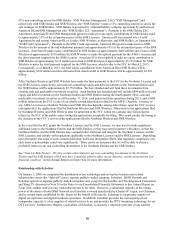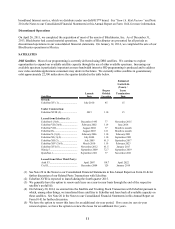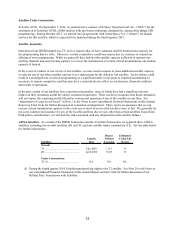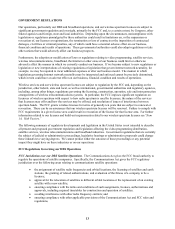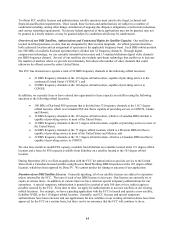Dish Network 2014 Annual Report Download - page 15
Download and view the complete annual report
Please find page 15 of the 2014 Dish Network annual report below. You can navigate through the pages in the report by either clicking on the pages listed below, or by using the keyword search tool below to find specific information within the annual report.5
5
Competition
As of December 31, 2014, we had 13.978 million pay-TV subscribers, representing approximately 14% of pay-TV
subscribers in the United States, and 0.577 million broadband subscribers. We face substantial competition from
established pay-TV providers and broadband service providers and increasing competition from companies
providing/facilitating the delivery of video content via the Internet to computers, televisions, and mobile devices.
As of September 30, 2014, roughly 100 million U.S. households subscribe to a pay-TV service.
Other Direct Broadcast Satellite Operators. We compete directly with DirecTV, the largest satellite TV
provider in the U.S. which had 20.2 million subscribers as of September 30, 2014, representing
approximately 20% of pay-TV subscribers. During May 2014, AT&T Inc. (“AT&T”) announced its
pending acquisition of DirecTV, which is currently undergoing regulatory review and has not been
completed. We filed a petition to impose conditions on the transaction with the FCC, to remedy potential
threats to consumers and competition in the video and broadband markets. If DirecTV ultimately is
acquired by AT&T, DirecTV will, among other things, have increased access to capital, access to AT&T’s
nationwide platform for wireless mobile video, and the ability to more seamlessly bundle its video services
with AT&T’s broadband Internet access and voice services. The combined company would also be able to,
among other things, pressure third-party content owners and programmers to withhold online rights from
us; utilize its increased leverage over third-party content owners and programmers to reduce the price it
pays for programming at the expense of other multichannel video programming distributors (“MVPDs”),
including us; thwart our entry into the wireless market, by, among other things, refusing to enter into data
roaming agreements with us; underutilize key orbital spectrum resources that could be more efficiently
used by us; foreclose or degrade our online video offerings at various points in the broadband pipe; and
impose anti-competitive data caps on consumers who access our online video offerings.
Cable Television Companies. We encounter substantial competition in the pay-TV industry from numerous
cable television companies that operate via franchise licenses across the U.S. As of September 30, 2014,
cable television companies have more than 54.0 million subscribers, representing approximately 54% of
pay-TV subscribers. Cable companies are typically able to bundle their video services with broadband
Internet access and voice services and many have significant investments in companies that provide
programming content. During February 2014, Comcast Corporation (“Comcast”) announced its pending
acquisition of Time Warner Cable Inc. (“Time Warner Cable”), which would combine the largest and
second largest cable television providers in the U.S. This acquisition is currently undergoing regulatory
review and has not been completed. We filed a petition to deny the transaction with the FCC, in which we
stated, among other things, that the proposed transaction poses serious harm to competition and consumers
and runs counter to U.S. antitrust and communications laws, that no set of conditions can alleviate these
harms, and that the FCC and Department of Justice should reject the transaction. If Time Warner Cable
ultimately is acquired by Comcast, the combined company would be able to, among other things, foreclose
or degrade our online video offerings at various points in the broadband pipe; impose anti-competitive data
caps on consumers who access our online video offerings; foreclose access to, or raise the prices of, its own
affiliated programming to us; pressure third-party content owners and programmers to withhold online
rights from us; and utilize its increased leverage over third-party content owners and programmers to
reduce the price it pays for programming at the expense of other MVPDs, including us.
Telecommunications Companies. Large telecommunications companies have upgraded older copper wire
lines with fiber optic lines in certain markets. These fiber optic lines provide high capacity bandwidth,
enabling telecommunications companies to offer video content that can be bundled with their broadband
Internet access and voice services. In particular, AT&T and Verizon Communications Inc. (“Verizon”)
have built fiber-optic based networks to provide video services in substantial portions of their service areas.
As of September 30, 2014, AT&T and Verizon had approximately 6.1 million U-verse and 5.5 million
FiOS TV subscribers, respectively. These telecommunications companies represent approximately 12% of
pay-TV subscribers.
Internet Delivered Video. We face competition from content providers and other companies including,
among others, Netflix, Hulu, Apple, Amazon and Google, who distribute video directly to consumers over
the Internet. In addition, programming offered over the Internet has become more prevalent and consumers


